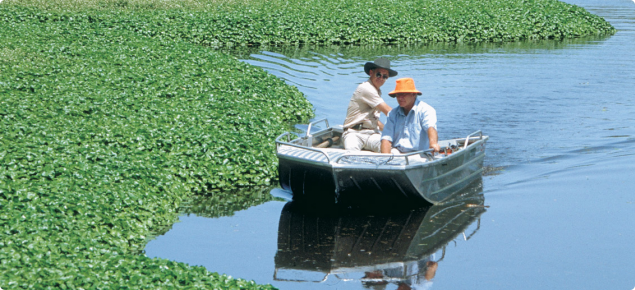Aquatic weeds in farm dams
Why are weeds there?
For weeds to be a problem in farm dams, there needs to be nutrient rich water or soil in the dam, and weed seeds or other plant material added to the dam.
Many farm dams collect water that has flowed across fertilised and disturbed paddocks. As a result, these dams accumulate silt and nutrients that favour aquatic weed growth.
Farm dams are a favoured source of water and breeding environment for water birds, and these birds will introduce weed seeds and nutrients to those dams. Aquatic weeds provide food and shelter for bird life, small crustaceans and fish. See the aquatic weeds page for more information.
Are the weeds native or declared?
Although farmers are often concerned about whether the weed is declared or is a potential problem, most water weeds sent for identification are native plants that present few problems.
Most commonly found species belong to the pond weed family: Potamogetonaceae. Of these, floating pond weed (Potamogeton tricarinatus), and blunt pond weed (Potamogeton ochreatus) are the most common. Duckweed (Lemna spp.), red azolla (Azolla spp.) and common water milfoil (Myriophyllum crispatum) are also widely distributed, but stonewort (Chara spp.), and sea tassel (Ruppia maritima) are also occasionally reported.
Declared aquatic weeds found in WA include water hyacinth (Eichornia crassipes), salvinia (Salvinia molesta), parrot’s feather (Myriophyllum aquaticum), hydrocotyle (Hydrocotyle ranunculoides) and leafy elodea (Egeria densa). These are not common on farm dams.
Categories of aquatic weeds
Knowing which category of weeds you have will help you select the right control.
- Emergent: weeds that have stems and leaves protruding above the water surface or grow where the watertable is near ground level. Examples are cumbungi, rushes, sedges, paspalum, water couchgrass, arum lily.
- Free floating: these weeds are not attached to the soil, but they may have root systems. Examples are salvinia, water lettuce and water hyacinth (in deep water).
- Floating leaf: these water weeds are rooted to the soil but have long stems that stretch to the water surface and floating leaves. Examples are water lilies, nardoo and hydrocotyle.
- Submerged: these water weeds are mostly completely submerged in shallow water 3 to 4m depth. They are rooted to the soil. Examples are pond weeds (Potamogeton spp.) and elodea.
Aquatic weed control
We recommend a 3 stage decision process:
- Do nothing. Growing submerged weeds uses the nutrients that may be used by toxic blue-green algae. If they are not blocking pumps, leave them.
- Mechanically remove the weeds from the dam if the weeds are blocking a pump. Perhaps you could drag the dam with a length of old mesh or ringlock.
- As a last resort, use Reglone (diquat) at the label recommendation for submerged weeds (5 parts per million of active ingredient, equivalent to 5L per 1000m3 of water).
We also recommend desilting dams whenever practical, to remove accumulated soil and nutrients that favour weed growth.
Mechanical control
Mechanical control such as cutting, mowing, dredging, drying and chaining may be necessary and effective in small areas, particularly where chemical control is not appropriate. Mechanical control can be expensive, and short-lived. Avoid spreading weeds from root or stem fragments.
Chemical control
Killing weeds and leaving them in the dam is likely to release a lot of nutrients, and make the water less attractive to livestock. If nutrients are released in summer, toxic blue-green algae blooms are possible
Use this check list before starting:
- Confirm the weed identity.
- Check if there's a registered herbicide for that weed in the dam.
- Check the withholding periods and environmental impacts of suitable herbicides.
- Have the correct application equipment.
- Arrange for alternative water sources for the withholding period.
- Plan for cleaning contaminated dams.
Using herbicides for aquatic weed control
Read the following documents before using herbicides for aquatic weed control:
- Protecting public drinking water source areas (Department of Water and Environmental Regulation).
- Pesticides Monitoring Exclusion Policy (Department of Health).
Check registrations and labels on the Public Chemical Registration Information System Search.
Emergent weeds
Glyphosate, where recommended on the label for aquatic areas, at the stated label rates is now the preferred herbicide for most emergent aquatic weeds. Many glyphosate products now have 'frog friendly' surfactants and are registered for aquatic weeds. Reglone® and dichlobenil are also approved for use in Western Australia (but please check this for any changes in approval).
Before selecting any other herbicide for use near rivers or drainage areas, check with the Department of Health telephone +61 (08) 9222 4222 (switchboard).
Free floating and floating leaf weeds
A range of chemicals can be used on floating aquatic weeds. The choice will depend on the weed species and the situation in which the weed is being sprayed. Reglone® (diquat), 2,4-D, glyphosate (when weeds are actively growing and not liable to submergence) and Casoron® (dichlobenil) all have their place.
Submerged weeds
Add enough herbicide to get the recommended concentration in the dam water.
Herbicides used for submerged weed control are Reglone® (diquat), and Casoron® (dichlobenil granulated). Reglone has a 24-hour withholding period for human and livestock consumption, and a 10-day withholding period for overhead irrigation.
Always read and comply with the label recommendations.
Reducing the likelihood of aquatic weed growth
The most practical way of reducing the likelihood of aquatic weeds in a dam, is to reduce or prevent silt and nutrients from entering the dam.
- Use a silt trap in front of the dam, and clean it out regularly.
- Use roaded catchments to collect water, instead of grade banks.
Further Information
More information on controlling declared plants can be found in the Declared plant control handbook.

